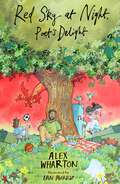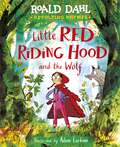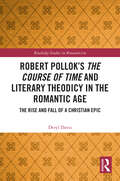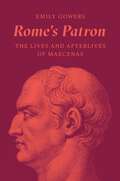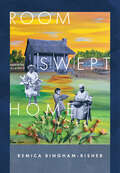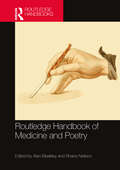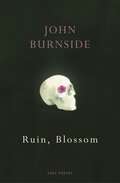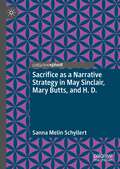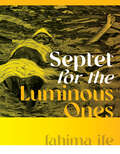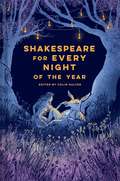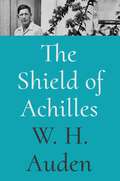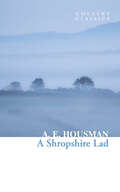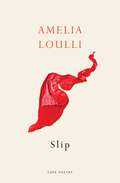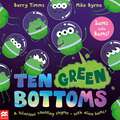- Table View
- List View
Red Sky at Night, Poet's Delight
by Alex WhartonRed Sky at Night, Poet's Delight is the second collection of funny and thoughtful poems from Alex, aimed at developing a love of language and self-expression. Readers will be excited by fun new characters like Mr Slime and the return of Hector the Horrible Hedgehog from Daydreams and Jellybeans, as well as being introduced to powerful and moving poems such as 'Young Oak', 'The Long Way Home', and 'For a Quiet Day'.
Rediscovering Rubén Darío through Translation
by Dr. Carlos F. GrigsbyA long overdue examination of Rubén Darío's multilingual work and influences alongside the contexts and politics of canonization in world literature. Rediscovering Rubén Darío through Translation addresses the peculiar obscurity of Darío by asking these questions: How can one of the most important writers of a major world language be almost entirely unknown in the English-speaking world? How is it that other writers of the same language (e.g., Lorca or García Márquez) achieve widespread recognition in the anglophone world, while he remains unnoticed? What role does translation play in this? What can it tell us about the way in which world literature is articulated? Carlos F. Grigsby approaches Darío's oeuvre through translation. In doing so, he explores not only the place of Darío in the translation of Spanish American literature into English, but also the place of translation in Darío's own writing. The result is a double-sided painting, as it were: the recto is titled “Translation in Darío” and the verso “Darío in Translation.” This book challenges the field of world literature by revealing some of the biases present in its representation of Spanish American literature. It adopts a multilingual framework – chiefly using English, Spanish, French, and to a lesser degree Latin and Catalan – in analyzing Darío's writing alongside that of his contemporaries. As a result, it reveals the multilingualism of Darío's own writing, opening new avenues for the study of his work and of Spanish American modernismo more generally.
Revolting Rhymes: A new picture book featuring Roald Dahl’s original rhyme
by Roald DahlI bet you think you know this story . . .Meet Red Riding Hood as you've never seen her before in this hilarious picture book twist on a classic fairy tale.After Wolfie gobbles Grandmamma in one big bite, he turns his attention to Miss Red Riding Hood. But little does he know, this small girl has a dastardly plan of her own.With brand-new and wickedly funny illustrations, this splendiferous rhyming picture book is perfect for chiddlers who like their fairy tales with a splash of daring and danger! The first in a brand-new picture book series adaptation of Roald Dahl's iconic Revolting Rhymes.Look out for these marvellous Roald Dahl books for little readers:Roald Dahl: My Dad is FantasticRoald Dahl: My Mum is MagnificentRoald Dahl: Revolting Things to Touch and FeelRoald Dahl: Disgusterous Noisy Sound BookRoald Dahl: On the First Day of ChristmasRoald Dahl: Easter EGGstravaganzaRoald Dahl: Trick or TreatRoald Dahl: Birthday BonanzaRoald Dahl: Fantastic FeelingsNever Grow Up
Robert Pollok’s The Course of Time and Literary Theodicy in the Romantic Age: The Rise and Fall of a Christian Epic (Routledge Studies in Romanticism)
by Deryl DavisThis book explores the contexts and reception history of Robert Pollok’s religious epic The Course of Time (1827), one of the best- selling long poems of the nineteenth century, which has been almost entirely forgotten today. Widely read in the United States and across the British Empire, the poem’s combination of evangelical Calvinism, High Romanticism, and native Scottishness proved irresistible to many readers. This monograph traces the poem’s origins as a defense of Biblical authority, divine providence, and religious orthodoxy (against figures like Byron and Joseph Priestley) and explores the reasons for The Course of Time’s enormous, decades- long popularity and later precipitous decline. A close reading of the poem and an examination of its reception history offers readers important insights into the dynamic relationship between religion and wider culture in the nineteenth century, the uses of literature as a vehicle for theological argument and theodicy, and the important but often overlooked role that religion played in literary— and, particularly, Scottish— Romanticism. This work will appeal to scholars of religious history, literary history, Evangelicalism, Romanticism, Scottish literature, and nineteenth- century culture.
Robert Pollok’s The Course of Time and Literary Theodicy in the Romantic Age: The Rise and Fall of a Christian Epic (Routledge Studies in Romanticism)
by Deryl DavisThis book explores the contexts and reception history of Robert Pollok’s religious epic The Course of Time (1827), one of the best- selling long poems of the nineteenth century, which has been almost entirely forgotten today. Widely read in the United States and across the British Empire, the poem’s combination of evangelical Calvinism, High Romanticism, and native Scottishness proved irresistible to many readers. This monograph traces the poem’s origins as a defense of Biblical authority, divine providence, and religious orthodoxy (against figures like Byron and Joseph Priestley) and explores the reasons for The Course of Time’s enormous, decades- long popularity and later precipitous decline. A close reading of the poem and an examination of its reception history offers readers important insights into the dynamic relationship between religion and wider culture in the nineteenth century, the uses of literature as a vehicle for theological argument and theodicy, and the important but often overlooked role that religion played in literary— and, particularly, Scottish— Romanticism. This work will appeal to scholars of religious history, literary history, Evangelicalism, Romanticism, Scottish literature, and nineteenth- century culture.
Rochester and the pursuit of pleasure
by Larry D CarverRochester and the pursuit of pleasure provides a reading of Rochester’s poems, dramatic works, and letters in a biographical context. In doing so, it sheds light on a central vexed issue in Rochester criticism, the relationship of the poet to his speaker. It also reveals that Rochester’s work clusters about a central theme, the pursuit of pleasure, a pursuit motivated by a courtship of purity that grew out of Rochester’s Christian and God-fearing upbringing. This rhetoric of courtship, in turn, reveals the unity of Rochester’s work as the courtier and his various personae try to persuade his audiences, secular and divine, of his worth.
Rochester and the pursuit of pleasure
by Larry D CarverRochester and the pursuit of pleasure provides a reading of Rochester’s poems, dramatic works, and letters in a biographical context. In doing so, it sheds light on a central vexed issue in Rochester criticism, the relationship of the poet to his speaker. It also reveals that Rochester’s work clusters about a central theme, the pursuit of pleasure, a pursuit motivated by a courtship of purity that grew out of Rochester’s Christian and God-fearing upbringing. This rhetoric of courtship, in turn, reveals the unity of Rochester’s work as the courtier and his various personae try to persuade his audiences, secular and divine, of his worth.
Rome's Patron: The Lives and Afterlives of Maecenas
by Emily GowersThe story of Maecenas and his role in the evolution and continuing legacy of ancient Roman poetry and cultureAn unelected statesman with exceptional powers, a patron of the arts and a luxury-loving friend of the emperor Augustus: Maecenas was one of the most prominent and distinctive personalities of ancient Rome. Yet the traces he left behind are unreliable and tantalizingly scarce. Rather than attempting a conventional biography, Emily Gowers shows in Rome’s Patron that it is possible to tell a different story, one about Maecenas’s influence, his changing identities and the many narratives attached to him across two millennia.Rome’s Patron explores Maecenas’s appearances in the central works of Augustan poetry written in his name—Virgil’s Georgics, Horace’s Odes and Propertius’s elegies—and in later works of Latin literature that reassess his influence. For the Roman poets he supported, Maecenas was a mascot of cultural flexibility and innovation, a pioneer of gender fluidity and a bearer of imperial demands who could be exposed as a secret sympathizer with their own values. For those excluded from his circle, he represented either favouritism and indulgence or the lost ideal of a patron in perfect collaboration with the authors he championed.As Gowers shows, Maecenas had and continues to have a unique cachet—in the fantasies that still surround the gardens, buildings and objects so tenuously associated with him; in literature, from Ariosto and Ben Johnson to Phillis Wheatley and W. B. Yeats; and in philanthropy, where his name has been surprisingly adaptable to more democratic forms of patronage.
Rome's Patron: The Lives and Afterlives of Maecenas
by Emily GowersThe story of Maecenas and his role in the evolution and continuing legacy of ancient Roman poetry and cultureAn unelected statesman with exceptional powers, a patron of the arts and a luxury-loving friend of the emperor Augustus: Maecenas was one of the most prominent and distinctive personalities of ancient Rome. Yet the traces he left behind are unreliable and tantalizingly scarce. Rather than attempting a conventional biography, Emily Gowers shows in Rome’s Patron that it is possible to tell a different story, one about Maecenas’s influence, his changing identities and the many narratives attached to him across two millennia.Rome’s Patron explores Maecenas’s appearances in the central works of Augustan poetry written in his name—Virgil’s Georgics, Horace’s Odes and Propertius’s elegies—and in later works of Latin literature that reassess his influence. For the Roman poets he supported, Maecenas was a mascot of cultural flexibility and innovation, a pioneer of gender fluidity and a bearer of imperial demands who could be exposed as a secret sympathizer with their own values. For those excluded from his circle, he represented either favouritism and indulgence or the lost ideal of a patron in perfect collaboration with the authors he championed.As Gowers shows, Maecenas had and continues to have a unique cachet—in the fantasies that still surround the gardens, buildings and objects so tenuously associated with him; in literature, from Ariosto and Ben Johnson to Phillis Wheatley and W. B. Yeats; and in philanthropy, where his name has been surprisingly adaptable to more democratic forms of patronage.
Room Swept Home (Wesleyan Poetry Series)
by Remica Bingham-RisherRoom Swept Home serves as a gloriously rendered magnifying glass into all that is held in the line between the private and public, the investigative and generative, the self and those who came before us. In a strange twist of kismet, two of Bingham-Risher's ancestors intersect in Petersburg, Virginia, forty years before she herself is born: her paternal great-great-great grandmother, Minnie Lee Fowlkes, is interviewed for the Works Progress Administration Slave Narratives in Petersburg in 1937, and her maternal grandmother, Mary Knight, is sent to Petersburg in 1941, diagnosed with "water on the brain"—postpartum depression being an ongoing mystery—nine days after birthing her first child. Marrying meticulous archival research with Womanist scholarship and her hallmark lyrical precision, Bingham-Risher's latest collection treads the murky waters of race, lineage, faith, mental health, women's rights, and the violent reckoning that inhabits the discrepancy between lived versus textbook history, asking: What do we inherit when trauma is at the core of our fractured living? [sample poem] XI. the more ground covered, the more liberated you became I am scared my mind will turn on me. I am scared I will be naked in a burning house. I am scared my children won't outpace me.I am scared my children (who aren't made by me) believe I am a sad imitation of the others.I am scared I will gather in a roomwhere everyone will ask me to rememberand when I don't lie they'll say I'd hate to be you. I've lived long enough to be scared my kidneys will give out on me. I've lived long enough to know just when they should. I have never shared my fears with anyone; I am scared they will map the land and take liberties. Will the women be ashamed? I'm scared to ask. What will live again? What will die with me?
Routledge Handbook of Medicine and Poetry
by Alan Bleakley Shane NeilsonThe Routledge Handbook of Medicine and Poetry draws on an international selection of authors to ask what the cultures of poetry and medicine may gain from reciprocal critical engagement. The volume celebrates interdisciplinary inquiry, critique, and creative expansion with an emphasis upon amplifying provocative and marginalized voices.This carefully curated collection offers both historical context and future thinking from clinicians, poets, artists, humanities scholars, social scientists, and bio-scientists who collectively inquire into the nature of relationships between medicine and poetry. Importantly, these can be both productive and unproductive. How, for example, do poet-doctors reconcile the outwardly antithetical approaches of bio-scientific medicine and poetry in their daily work, where typically the former draws on technical language and associated thinking and the latter on metaphors? How does non-narrative lyrical poetry engage with narrative-based medicine? How do poets writing about medicine identify as patients? Central to the volume is the critical investigation of the consequences of varieties of medical pedagogy for clinical practice.Presenting a vision of how poetic thinking might form a medical ontology this thought-provoking book affords an essential resource for scholars and practitioners from across medicine, health and social care, medical education, the medical and health humanities, and literary studies.
Routledge Handbook of Medicine and Poetry
The Routledge Handbook of Medicine and Poetry draws on an international selection of authors to ask what the cultures of poetry and medicine may gain from reciprocal critical engagement. The volume celebrates interdisciplinary inquiry, critique, and creative expansion with an emphasis upon amplifying provocative and marginalized voices.This carefully curated collection offers both historical context and future thinking from clinicians, poets, artists, humanities scholars, social scientists, and bio-scientists who collectively inquire into the nature of relationships between medicine and poetry. Importantly, these can be both productive and unproductive. How, for example, do poet-doctors reconcile the outwardly antithetical approaches of bio-scientific medicine and poetry in their daily work, where typically the former draws on technical language and associated thinking and the latter on metaphors? How does non-narrative lyrical poetry engage with narrative-based medicine? How do poets writing about medicine identify as patients? Central to the volume is the critical investigation of the consequences of varieties of medical pedagogy for clinical practice.Presenting a vision of how poetic thinking might form a medical ontology this thought-provoking book affords an essential resource for scholars and practitioners from across medicine, health and social care, medical education, the medical and health humanities, and literary studies.
Ruin, Blossom
by John BurnsideA remarkable new collection exploring ageing, mortality and environmental destruction - from our finest Scottish lyric poet**WINNER OF THE DAVID COHEN PRIZE FOR LITERATURE 2023**'By far the best British poet alive' SPECTATOR'A master of language' HILARY MANTELIn this powerful, moving new book, John Burnside takes his cue from Schiller, who recognised that, as one thing fades, so another flourishes: everywhere and always, in matters great and small, new life blossoms amongst the ruins.Here, in poems that explore ageing, mortality, environmental destruction and mental illness, Burnside not only mourns what is lost in passing, but also celebrates the new, and sometimes unexpected, forms that emerge from such losses. An elegy for a dead lover ends with a quiet recognition of everyday beauty – first sun streaming through the trees … a skylark in the near field, flush with song – as the speaker emerges from lockdown after a long illness.Throughout, the poet attends to the quality of grace – numinous, exquisite, fleeting as an angel’s wing – and the broken tryst between humankind and its spiritual and animal elements, even with itself: the gaunt deer on the roads/like refugees. He acknowledges the inevitability of the fading towards death, but still finds chimes of light in the darkness – insisting that, here and now, even in decline, the world, when given its due attention, is all Annunciation.
Sacrifice as a Narrative Strategy in May Sinclair, Mary Butts, and H. D.
by Sanna Melin SchyllertThis book explores sacrifice as a narrative theme and a stylistic strategy in works by May Sinclair, Mary Butts and H. D. It argues that the modernist experiment with pronoun use informs the treatment of acts of sacrifice in the texts, understood both as acts of self-renunciation and as ritual performance. It also suggests that sacrifice, if the conditions are right, can serve as the structure upon which a cohesive community might be built. The book offers in-depth analyses of the three authors and their works, deftly dissecting the modernist narrative experiment to show that it was by no means limited — it was a means by which to approach a wide range of stories and materials.
Septet for the Luminous Ones (Wesleyan Poetry Series)
by fahima ifeContinuing her search for a neotropical mythos, in this brilliant second collection poet fahima ife articulates various scenes of subduction. Spoken in quiet recognition and grounded in desire, Septet for the Luminous Ones imagines a lush soundscape textured in oblique spiritual fusion of the Taíno and Yoruba. Or, what it sounded like coming together for the first time, and what it sounds like ever after—breathless, diaspora calling. Similar to the incidents in Maroon Choreography, what resounds in these poems is an ecstatic love song of the Caribbean Americas, of the main lands and islands, shaped and reshaped as breathwork, ritual, communion, and fantasy. In essence, the collection speaks to raise the vibrational frequencies of all species on Earth through a sensual pulse of Black English.From Alchemical Sirensit flickers in balsamic appealmoist in the palms of our handsa psalm a lamp a sap in our lapsan aspplausible love song after love poemswere last put on holdas in b l a ck a r tthe new black art is this — find the lost soul and love it
Shakespeare for Every Night of the Year
by Colin SalterImmerse yourself in the sublime words of the Bard with this sumptuous anthology of Shakespeare, with one entry for every night of the year. Chosen especially by a Shakespeare fanatic to reflect the changing seasons and daily events, the entries in this glorious book include: Romeo and Juliet on Valentine's Day. A Midsummer Night's Dream in Midsummer. The witches of Macbeth around their cauldron on Halloween. Also featured is one of Shakespeare's only two mentions of football for the anniversary of the first FA cup final. Beautifully illustrated with favourite scenes from Shakespeare's best-loved plays, this magnificent volume is a fun introduction to the well-known work and lesser known plays and poetry and is designed to be accessible to both adults and curious children. Keep this book by your bedside and luxuriate in the rich language of the greatest writer the world has ever known, for entertainment, relaxation and timeless wisdom every night of the year.
The Shield of Achilles (W. H. Auden: Critical Editions Ser. #1)
by W. H. AudenBack in print for the first time in decades, Auden&’s National Book Award–winning poetry collection, in a critical edition that introduces it to a new generation of readersThe Shield of Achilles, which won the National Book Award in 1956, may well be W. H. Auden&’s most important, intricately designed, and unified book of poetry. In addition to its famous title poem, which reimagines Achilles&’s shield for the modern age, when war and heroism have changed beyond recognition, the book also includes two sequences—&“Bucolics&” and &“Horae Canonicae&”—that Auden believed to be among his most significant work. Featuring an authoritative text and an introduction and notes by Alan Jacobs, this volume brings Auden&’s collection back into print for the first time in decades and offers the only critical edition of the work.As Jacobs writes in the introduction, Auden&’s collection &“is the boldest and most intellectually assured work of his career, an achievement that has not been sufficiently acknowledged.&” Describing the book&’s formal qualities and careful structure, Jacobs shows why The Shield of Achilles should be seen as one of Auden&’s most central poetic statements—a richly imaginative, beautifully envisioned account of what it means to live, as human beings do, simultaneously in nature and in history.
A Shropshire Lad (Collins Classics)
by null A.E. HousmanHarperCollins is proud to present its incredible range of best-loved, essential classics. What are those blue remembered hills, What spires, what farms are those? First published in 1896, A.E. Housman’s best-loved collection of poetry is a poignant exploration of love, loss, the inevitable passage of time and the fragility of life. Using elegant melodic simplicity, Housman’s poems arouse profound emotional resonance through their portrayal of an idyllic rural England, evoking a sense of nostalgia and longing for times gone by. A Shropshire Lad became popular with young British soldiers during the First World War and is now widely considered a classic work of English poetry. With lyrical beauty and universal themes, these 63 poems have inspired generations of readers across the world.
Sir Philip Sidney: The New Arcadia, Second Revised Edition (The Manchester Spenser)
by J. B. Lethbridge Elisabeth Chaghafi Victor SkretkowiczModern readers mostly know Sir Philip Sidney’s Arcadia in its complete ‘old’ version, but it is the New Arcadia (published in 1590), a revised version of his pastoral romance The Countess of Pembroke’s Arcadia, that was the most influential and most widely imitated literary text of the sixteenth century. Preserving the basic plot, New Arcadia adds further narrative strands and introduces ambitious revisions, demonstrating Sidney’s brilliance as a prose writer.This edition of the New Arcadia is the first in nearly four decades, preserving the text of Victor Skretkowicz’ celebrated 1987 edition, whilst making the text accessible through modern spelling and supplementing it with a substantially expanded scholarly commentary, an updated glossary, and additional long notes on the book’s history and Sidney’s use of rhetorical devices, as well as his contributions to the English language.
Skeletons
by Deborah LandauWitty and glam, Skeletons is a prismatic collection which shrugs off even the most disillusioned nihilist with humour and intimacy.
Slip: From the Winner of the Northern Writers’ Award
by Amelia LoulliOne in three women in Britain have an abortion. For such a common procedure, it has not been the subject of a dedicated book of poetry - not, at least, until now.'Painful, brave and steadfastly honest' ANDREW MCMILLAN'Original, essential... An unforgettable collection' FIONA BENSONAmelia Loulli opens this fearless, frank, absorbing debut with the words 'I'm going to tell you what happened', and that is precisely what she does. With these careful, generous, insistent poems, we are led through the experience of abortion and surprised at every turn. There is vulnerability and despair, there is the shame and silence too, but there is also the constant, steady pulse of compassion, tenderness and wonder at the world.Slip is a daring book, not just in subject but in style: skilfully worked, integrating the rich terror of nursery rhymes and folk tales with the bland banalities and euphemisms of social interaction, of medical techniques. It is also, sadly, a necessary book - provocative and transformative poetry about women as mothers and survivors. A cry of fury and a cry of love.
Style and Sense(s)
by Sandrine Sorlin Linda PillièreThis edited volume celebrates cutting-edge research in stylistics and, more specifically, recent work on sense and the senses. The title originated in the Poetics and Linguistics Association (PALA) 2022 conference and marks the 40th onsite event by showcasing some of the excellent papers delivered on that occasion. The selected chapters fall into 4 parts each of which gives pride of place to how style makes sense and how senses make style. The chapters follow research in neuroscience and sociocognition, investigate how body and mind are inextricably linked through embodied meaning; how emotions are both conveyed and perceived; and how impressions, thoughts and worldviews can be induced by a certain style. The apprehension of the senses is carried through a variety of theories (cognitive linguistics and stylistics, ecostylistics, phenomenology, simulation theory, enactivism, metaphor theory, Text World Theory) and is applied to various genres (poetry, novels, short stories, detectivefiction, restaurant reviews) and media (the oral vs written tradition, ekphrasis, and semiotic transfers). This book will be of interest to students and academics in stylistics, cognitive linguistics, discourse analysis, ecostylistics, and multimodality.
Teach This Poem, Volume I: The Natural World
by Madeleine Fuchs Holzer The Academy of American PoetsInstill a love of poetry in your classroom with the illuminating and inviting lessons from Teach This Poem classroom activities. Co-published with the Academy of American Poets, the leading champion of poets and poetry in the US, this book is an accessible entry-point to teaching poetry and fostering a poetic sensibility in the classroom.Each lesson follows a consistent format, with a warm-up activity to introduce the chosen poem, pair-shares, whole class synthesis, related resources, oral readings, and extension activities. Curated by the AAP, the poems are chosen with an eye toward fostering compassion and representing diverse experiences. Understanding that poetry is a powerful way of seeing the world, the volumes are organized thematically: Volume I is centered on the natural world and Volume II on equality and justice.Aligned with current standards and pedagogy, the lessons in this poem will inspire English teachers and their students alike.
Teach This Poem, Volume I: The Natural World
by Madeleine Fuchs Holzer The Academy of American PoetsInstill a love of poetry in your classroom with the illuminating and inviting lessons from Teach This Poem classroom activities. Co-published with the Academy of American Poets, the leading champion of poets and poetry in the US, this book is an accessible entry-point to teaching poetry and fostering a poetic sensibility in the classroom.Each lesson follows a consistent format, with a warm-up activity to introduce the chosen poem, pair-shares, whole class synthesis, related resources, oral readings, and extension activities. Curated by the AAP, the poems are chosen with an eye toward fostering compassion and representing diverse experiences. Understanding that poetry is a powerful way of seeing the world, the volumes are organized thematically: Volume I is centered on the natural world and Volume II on equality and justice.Aligned with current standards and pedagogy, the lessons in this poem will inspire English teachers and their students alike.
Ten Green Bottoms: A laugh-out-loud rhyming counting book
by Barry TimmsCount down from ten with the cheeky aliens and do your 'sums with bums' in Ten Green Bottoms – a hilarious storybook for preschoolers, which is a twist on the classic nursery rhyme Ten Green Bottles. Join the green-bottomed aliens and their ‘wind-powered' rocket as they cause all kinds of mischief on Earth. Packed full of silly humour and with lots to spot in busy scenes, this riotous rhyming story by Barry Timms and Mike Byrne is perfect for reading aloud and sharing.With a surprise gatefold ending, a number line to count up to ten and back down again plus a page of simple adding up, first maths skills have never been so much fun!
